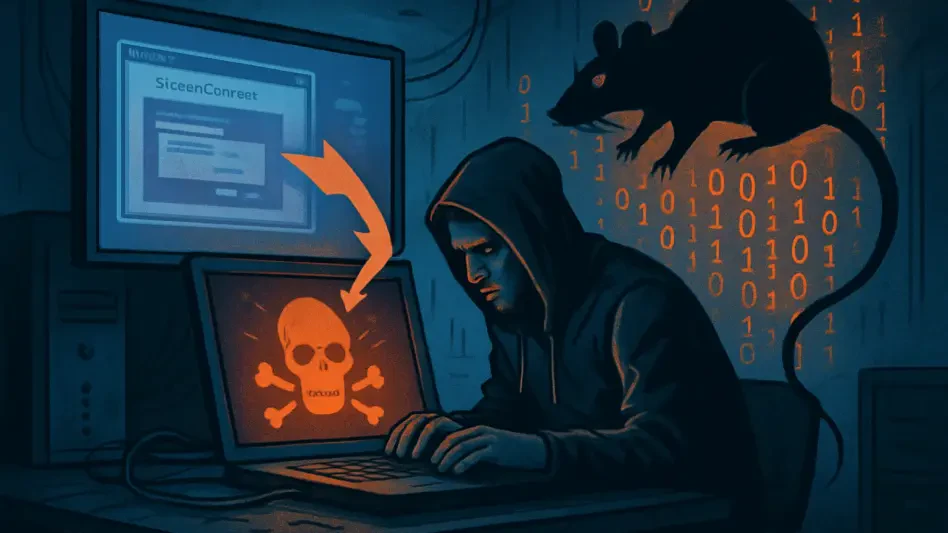In the shadowy realm of cybersecurity, a disturbing trend has emerged as malicious actors increasingly exploit trusted tools to orchestrate devastating attacks, with ConnectWise ScreenConnect, a widely used Remote Monitoring and Management (RMM) software, becoming a prime target for such exploitation. Attackers are trojanizing its installers to deploy dual Remote Access Trojans (RATs)—namely AsyncRAT and custom PowerShell RATs—primarily targeting organizations across the United States by leveraging the inherent trust and elevated system privileges associated with RMM tools to bypass conventional security barriers. The result is stealthy, long-term access to compromised systems, posing a significant challenge to defenders. This article delves into the mechanics of these supply chain attacks, explores the sophisticated methods employed by threat actors, and examines the evolving strategies needed to counter this persistent threat in an ever-changing digital landscape.
Exploiting Trust in Software Supply Chains
The manipulation of ScreenConnect underscores a broader wave of supply chain attacks where legitimate software is repurposed as a conduit for malware. Attackers exploit the deep system access and implicit trust that RMM tools like ScreenConnect command, allowing them to evade traditional security protocols with alarming ease. By embedding malicious code within installers, these adversaries deploy dual RATs to ensure redundancy—if one payload is detected and neutralized, the other remains active, maintaining a foothold in the compromised environment. This approach not only maximizes the chances of persistence but also highlights the vulnerability of trusted software in modern cybersecurity. As organizations rely heavily on such tools for remote operations, the risk of these attacks grows, necessitating a reevaluation of how trust is assigned to software within critical systems and pushing the need for more stringent verification processes to prevent such exploitation from taking root.
Moreover, the strategic choice of ScreenConnect as a delivery mechanism reveals the calculated nature of these campaigns. Threat actors understand that RMM tools often operate with high-level permissions, making them ideal for bypassing endpoint security measures that might otherwise flag suspicious activity. The dual-RAT strategy, combining AsyncRAT with a custom PowerShell RAT, demonstrates a layered attack model designed to adapt to defensive responses. This exploitation of trust extends beyond mere technical manipulation; it preys on the human tendency to accept familiar software as safe, often overlooking subtle signs of tampering. As supply chain attacks continue to rise, this trend serves as a stark reminder that even the most reliable tools can be turned against users, urging a shift toward proactive validation of software integrity and deeper scrutiny of third-party applications integrated into organizational workflows.
Unpacking the Complex Attack Chain
These campaigns employ a multi-stage attack process that begins with trojanized ScreenConnect installers, often hosted in open directories with dynamic paths like /Bin/ and bearing names such as logs.ldk. Ranging in size from 60 KB to 3 MB, these installers initiate a cascade of malicious actions, utilizing VBScript or JavaScript droppers and PowerShell loaders like Skype.ps1 to execute their payloads. Native injection techniques, often facilitated by libraries like libPK.dll, further embed the malware into system processes. A critical element of this infection chain is social engineering, with attackers crafting lures that mimic trusted entities such as IRS notifications or Zoom updates to deceive users into running the corrupted files. This blend of technical sophistication and psychological manipulation ensures a high success rate for initial infections, exploiting both system vulnerabilities and human error to establish a foothold within targeted networks.
Beyond the initial breach, the attack chain is designed for resilience, adapting to different environments and defensive measures. Once executed, the installers deploy their dual RATs through a series of obfuscated scripts and loaders, making detection by traditional antivirus solutions challenging. The use of familiar branding in social engineering tactics adds a layer of deception, as users are more likely to trust prompts that appear to come from reputable sources. This multi-pronged approach not only facilitates the spread of malware but also complicates efforts to trace the origin of the attack, as each stage is carefully crafted to obscure the malicious intent. As defenders grapple with identifying these threats, the importance of user education alongside robust technical controls becomes evident, emphasizing the need for a comprehensive strategy to disrupt such intricate infection processes before they can cause widespread damage.
Stealth Tactics and Persistence Mechanisms
To remain undetected, attackers employ advanced evasion techniques, loading malicious payloads directly into memory using methods like .NET’s Assembly.Load, thereby avoiding on-disk detection that could trigger alerts. They further obscure their presence by injecting code into trusted Windows processes such as AppLaunch.exe, blending seamlessly with legitimate system activity. Persistence is secured through scheduled tasks with cryptic names like 3losh, configured to execute as frequently as every two minutes, ensuring continuous operation even after system reboots. Network communications are masked by using both standard ports like 80 and 443, as well as high ephemeral ports ranging from 30,000 to 60,000, often encrypted with TLS to evade inspection. Such meticulous tradecraft underscores the lengths to which attackers go to maintain access while frustrating conventional detection methods reliant on static signatures.
Additionally, the frequent repacking of executables and dynamic rotation of domains add further complexity to tracking and mitigating these threats. By constantly altering the structure of their malware and shifting the infrastructure used for command and control, attackers ensure that security tools struggle to keep pace with the evolving threat. This adaptability is a hallmark of modern cyber campaigns, where persistence is prioritized over immediate impact, allowing for prolonged espionage or data exfiltration. Encrypted traffic over varied ports complicates network monitoring, as distinguishing malicious activity from legitimate communications becomes a daunting task. For organizations, this necessitates a shift toward behavior-based detection systems capable of identifying anomalies in process execution and network patterns, rather than relying solely on known indicators that are quickly rendered obsolete by such dynamic tactics.
Infrastructure and Coordinated Threat Operations
The infrastructure supporting these attacks reveals a highly coordinated operation, with at least eight identified hosts distributing malicious ScreenConnect installers and tied to wider AsyncRAT campaigns. Recurring URL structures, such as /Bin/, have been observed in phishing efforts dating back to previous years, pointing to a consistent and reusable attack framework. Specific indicators, like activity on port 5050, have been flagged by threat intelligence platforms as markers of malicious behavior, providing valuable leads for defenders. This modular setup, where infrastructure components are repurposed across multiple campaigns, reflects an efficient and evolving threat operation designed to target diverse victims while maintaining operational flexibility. Such patterns highlight the importance of sharing intelligence across sectors to map and disrupt these networks before they can scale further.
Furthermore, the use of open directories to host trojanized installers demonstrates a deliberate choice to exploit less-secured environments for payload distribution. These hosts often serve as temporary staging grounds, quickly replaced or reconfigured to evade takedown efforts by security teams or hosting providers. The recurring infrastructure patterns offer actionable insights for defenders, yet the rapid adaptability of these setups poses a significant challenge to sustained disruption. Collaborative efforts between organizations, threat intelligence communities, and cybersecurity authorities are crucial to identify and neutralize these hosts promptly. By focusing on dismantling the underlying infrastructure, rather than merely addressing individual payloads, a more effective barrier can be erected against the spread of such threats, limiting the operational reach of attackers leveraging these coordinated systems.
Adapting Defenses to Evolving Threats
The trend of weaponizing RMM tools like ScreenConnect signals a paradigm shift in cyber threats, where trusted software becomes a gateway for malicious activity, rendering traditional antivirus solutions inadequate. Techniques such as in-memory execution and native process injection challenge static detection methods, while social engineering exploits human trust in familiar brands, amplifying infection rates. To combat this, organizations must pivot to behavior-based defenses, monitoring for anomalies in system processes and network traffic rather than relying on outdated signature databases. Implementing strict allowlisting for RMM installers, validated through signer metadata and vendor checks, can prevent trojanized binaries from executing, while endpoint security platforms should be tuned to detect in-memory compilation and DLL injections as early warning signs of compromise.
In response to these sophisticated threats, proactive threat hunting emerges as a critical strategy, targeting specific indicators like Ab.vbs droppers, Skype.ps1 loaders, and scheduled tasks with names like 3losh. Network defenses should scrutinize unusual Content-Type responses for /Bin/ downloads and ClickOnce URLs, while blocking execution from publicly writable directories like C:\Users\Public adds an additional layer of protection. Layered defenses, combining behavioral endpoint detection and response (EDR) with TLS inspection and stringent RMM controls, form a robust barrier against these attacks. Looking ahead, continuous monitoring of infrastructure patterns and modular payloads will be essential to stay ahead of dynamic threats. By adopting these adaptive measures and fostering collaboration with hosting providers and CERTs to dismantle malicious infrastructure, organizations can better safeguard their systems against the persistent danger posed by weaponized software tools.








